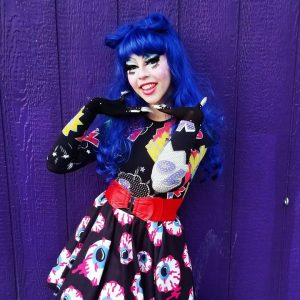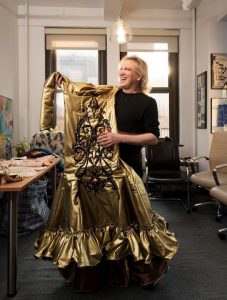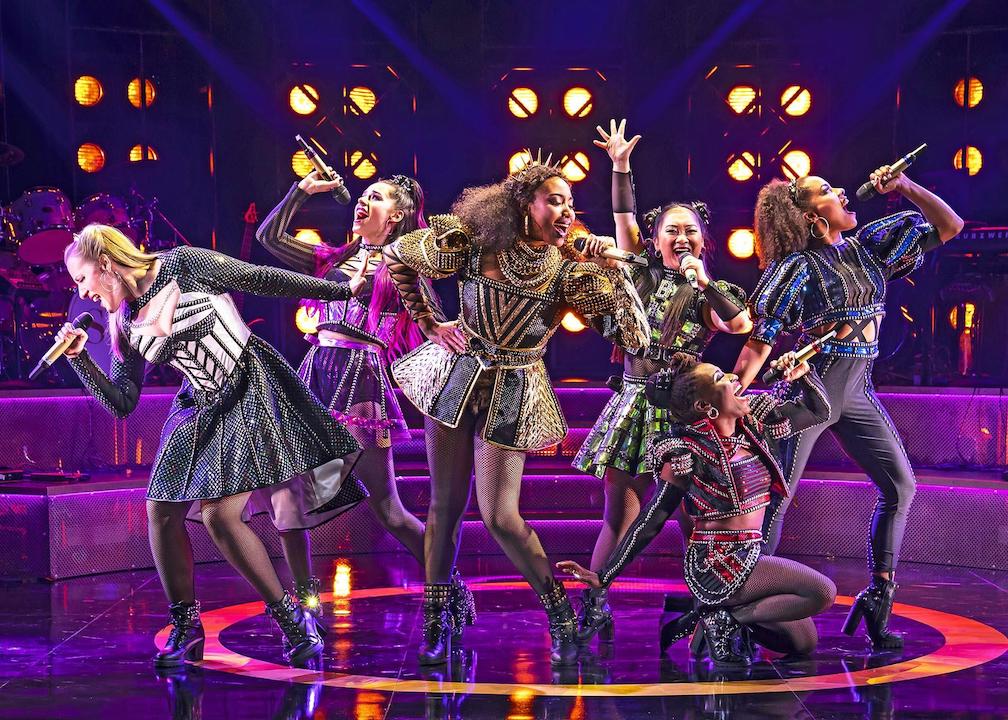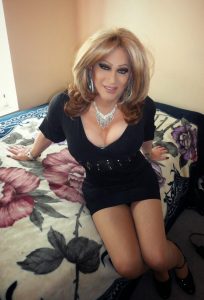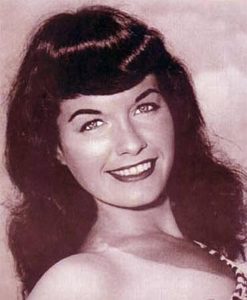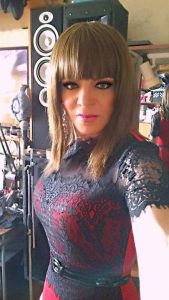Dina’s Diner 2/10/20
THE GIRL CAN’T HELP IT
I saw an interesting article on The Huffington Post website headlined I’m a 13 Year Old Girl and I’m a Drag Queen. The profile of 13 year old Bracken Hanke appeared on February 1, 2020.
After a few years of trans kids coming out and pre-teen boys adopting drag personas, I have to admit this was a new one to me. I’ve heard of drag kings where women dress up as male archetypes but not women doing female drag. Even so, in the context of a young girl, it kind of makes sense. The article delves into her drag persona.
Bracken’s mother is a dress and hat designer so she has always been around fashion and runway models. She aspired to walk the runway like the older women. When she saw RuPaul’s Drag Race on television she was inspired by the outrageous fashions and personas of the performers. However, her Mom would not let her “do drag” since she was still only a grade schooler. After befriending a local drag queen at the Vancouver Canada Pride parade, Mom finally broke down and Bracken began developing her drag look and did her first lip-synch performance during the Vancouver Pride Week at age 11. She has since performed in Montreal where she met some other young boy drag queens (like Suzan Bee Anthony who I wrote about in 2018 in the Diner).
The article mentioned that one reason — aside from the age issue — Bracken’s Mom was reluctant to encourage her doing drag in public was that she was concerned about the cultural appropriation issue. Is it right for a young girl to impersonate a female impersonator? I came across a blogger who wrote that Bracken was not a “drag queen.” He felt that term was culturally significant in the gay community and is loaded with the underground history and subversiveness of the gay culture so he objected to a young girl using that term. Think Stonewall, for instance. There is some resistance to the sudden popularity of drag and drag superstars, to say nothing of the nascent school-age drag scene.
In her HuffPost essay she wrote: “I often get asked why I love drag, and the answer always stays the same: Drag brings me so much happiness. It is my creative outlet, it helps me express myself, and there are no rules or limits. I dance, sing, sew outfits, create characters and play dress-up. Drag also has a political side for me, too. As a young girl constantly being told by the media and society how I should look and behave, drag lets me poke fun at that idea and make a caricature of those expectations. When I am in drag, I can become whatever character I want, knowing I am just a couple of makeup wipes away from being “regular me” again. I enjoy just being regular me, but it can be fun to be someone else just for a minute.”
She also mentions hearing from other young trans kids, most of whom don’t have the same home support as Bracken is fortunate to have. “Some of these kids are really struggling. As a 13-year-old, it is hard to give them all the answers, but I am grateful I can help them to see they are not the only ones like them, and that they aren’t wrong, or alone.”
No matter where Bracken’s drag adventure takes her, she may have already helped others. That’s a good legacy for anyone of any age, from thirteen and up.
YOU’LL LAUGH, YOU’LL CRY, YOU’LL LAUGH AGAIN
The New York Times had a profile of playwright and actor Charles Busch in the January 12, 2020 edition. It was headlined Call Charles Busch a ‘Drag Legend’ If We Must Use Labels. Mr. Busch was in rehearsals for his latest theater production, a show he calls The Confession of Lily Dare. Charles Busch made his mark in contemporary theater as an actor playing female roles in his own productions beginning in the early 1980s. The shows feature the type of overwrought plotting and characters that were popular in female-centric melodramas of the Depression era.
The plot summary for Lily Dare has Charles “portraying an orphaned ingenue who becomes a sultry nightclub entertainer, loses her daughter while locked up in jail, then rebounds as the head of a bordello empire.” He has been writing and staging shows for an Off-Broadway theater in Manhattan for many years.The Times reported: “He works with specific references, but his material also works if you don’t know them,” said Jennifer Van Dyck, whose roles in Lily Dare, her fifth Busch play, include Lily’s opera-singing daughter, a madam, a doctor’s wife and a police officer going undercover as a baroness. Similarly, the characters Busch writes for himself are not impersonations: He tries to get into classic actresses’ heads rather than imitate their speech. After rehearsing a section in which Lily Dare confronts the man who caused her trip to jail, the soft-spoken Busch explained that it was a very Bette Davis style, but he was not doing her. “I’m intellectually approaching the scene, maybe, as she might have approached it,” he said. “I just love these movies so much that I don’t want to make fun of them; I just want to be in them.”
I wrote about Charles Busch several years ago when he was already well-known for his particular brand of theater and drag performance. He has done cabaret shows but is not a drag queen in the classic lip-sync camp vein of drag. I was surprised to learn he is now 65 years old and nice to hear that he’s still going strong. And why not? No one else seems to be trying to do what he does. He told the Times, “Everything in my life and who I am, I’m two sides of everything,” he said. “I’m male and female; I’m young, I’m old; I’m downtown, I’m mainstream; I’m the life of the party, I’m a recluse. I like to think that I’m ultimately an actor; but you live in the real world and you have to describe yourself, so I’ll be a drag legend. ‘Legend’ makes everything sound good. Anything legend — I’ll take it.”
THERE’S NO PEOPLE LIKE SHOW PEOPLE
The New York Times had an article about something called BroadwayCon in the January 30, 2020 edition. It was part reportage and part personal essay by reporter Nancy Coleman.
I never heard of BroadwayCon before but it’s been held for several years now as older Times articles bear out when I searched for more info. As all “Cons” go, this is a gathering of people of all ages who are in love with theater. “Take the most intense theater buff you knew in high school — you know the one — and multiply that person by 5,000. Let those enthusiasts dress up as their favorite characters and lip sync to their favorite showstopping numbers. Give them a chance to meet their Broadway idols and get their prized Playbills signed.”
The Times reporter took the opportunity to confess her own theater obsession dating from her schoolgirl days up to the present. So she admits to breaking objectivity when she wrote “I’ve long considered myself a Broadway fan, which made my assignment last weekend for the Times’s Culture desk particularly fun. Wandering among costumed fans — several striped Beetlejuices, a handful of Hamiltons, an 8-year-old in a Phantom of the Opera mask — and weaving through the occasional pop-up singalong session in the hallway, I felt right in my element.”
The thing that brought my attention to the article was a photo of some young women in fishnet tights who were at the convention to celebrate a new show called Six – which hasn’t even opened on Broadway yet! The concept of Six sounds interesting. It places the six wives of Henry VIII into an American Idol style singing competition. The out-of-town previews show the six leads in Beyoncé-like spangly show costumes with – yes! – fishnet tights.
There are all kind of “Cons” for all sorts of interests and obsessions after the success of ComicCon so many years ago. RuPaul organized a DragCon which I wrote about here previously. There are several regional crossdressing conventions still being held on an annual basis. There doesn’t seem to be a single big CrossdressingCon, though. Seems like it would be hugely attended and hugely fun if it was held in some international destination like New York, Los Angeles or London. Someone should really do this. Hey, don’t look at me, though.
FIFTY IS THE NEW HOT DAMN!
Almost everyone was talking about Jenifer Lopez’ Superbowl halftime performance. The common thread of most comments was that she is fifty years old and is still smoking hot in a sheer bodysuit. Oddly enough, I pointed to Jennifer in my last Diner (before the Superbowl) as a contrast to how fifty year old females were viewed a generation or more ago. Shakira, who was also in that halftime show is “only” 43 years old and she’s a smokehouse too.
This is not a new phenomenon. I remember when Jane Fonda turned 60 (which would have been in 1997), a magazine ran a photo of a still very attractive and fit Jane next to a photo of Aunt Bea (from The Andy Griffith Show) when she was 60. The contrast in style was jarring. Christie Brinkley is fogging men’s glasses with her swimsuit selfies in her mid-60s. Likewise Elizabeth Hurley (also mentioned here a several months ago) who is ageless in her mid-50s.
It strikes me as an evolutionary thing – partly human and partly technological. Similar to athletics where records are made to be broken by subsequent generations of players, standards of physical beauty and fitness keep marching forward. The technology advances in sports and training equipment aids player development to set new records. The technology of cosmetics, fashions and accessories helps advance the standards of beauty and aid those women who choose to focus on beauty and fashion. Maybe a modern day Aunt Bea could shake her booty in a sheer bodysuit if she invested as much effort and money in that endeavor as J.Lo, Shakira, and others.
It works that way for crossdressers too. How many times have you seen a crossdresser’s online photo album that seems to show her improving with age rather than the reverse? Years of experience, modern fashions, improved cosmetics, even better cameras all assist in helping us seem to defy aging – at least in some instances. And it’s a good thing, too, because most of us who came up and out during the crossdressing boom of the 1980s are at or approaching a certain age. Thank goodness for progress.
GANGS OF BANGS
I saw a local television commercial a few times recently and after the last viewing I took notice of the model’s pretty red hair with straight bangs. The bangs were a good look for her and framed her face which directed attention to her eyes and cheekbones. As I contemplated the role of bangs in her beauty, I realized I didn’t know why we call them bangs. Do you?
It turns out that the tails of racehorses are sometimes trimmed with a flat across cut and that became known as a bangtail. So women who trimmed their hair straight across their brow line were said to have “bangs.” You can learn a lot here at the Diner when you eat in instead of take out.
When I think of bangs, I only count those styles where the hair is combed straight down onto the forehead. Those downward swooping flips (think Marilyn Monroe or Farrah Fawcett) across the forehead are not pure bangs. For our purposes here, vintage pinup and bondage queen Bettie Page exhibits the classic set of bangs.
Maybe it is the lingering legacy of Bettie Page that lends the pure bangs style a playful sexiness. The girlishness of the unfussy bangs also hides the forehead behind which lies a devilish mind. (Or so we like to imagine.) Even today, 60-plus years after Bettie’s heyday, fetish models both real and drawn by artists often sport straight dark bangs as an homage to the enigmatic Bettie.
Bangs in more normal settings flourish also, of course. Taylor Swift is often in straight blond bangs mode. Doing a quick Google search for celebrities in bangs pulled up dozens of photos of actresses, models and musicians in bangs. Since women change their hairstyles so often, it seems like the bangs look is employed for specific effect. It can signal casualness (literally letting your hair down) or a youthful look for older women giving it a go. When the bangs are trimmed well above the brow line, it provides a comic superhero look with a hint of kinkiness.
Bangs are good for crossdressers too because it camouflages the false hairline of a wig. A large majority of crossdressers wear a style with hair falling on the forehead for that reason. But pure bangs is still a small minority of wig style for crossdressers based on my brief perusal of internet photo sites. And that’s just as well because pure bangs should remain a little out of the ordinary, something special.
Like to make a comment? Login here and use the comment area below.
Category: Transgender Opinion


